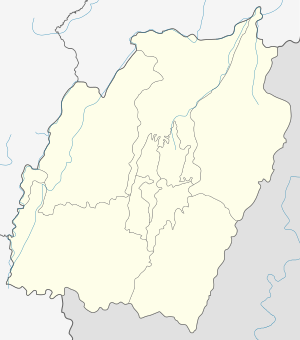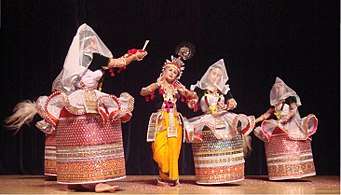Sacred Jackfruit Tree
The Sacred Jackfruit Tree is a historical site in the Indian state of Manipur where a jackfruit tree (Artocarpus heterophyllus) growing on the small hill of Kaina was used to carve images of Hindu god Krishna. Rajarshi Bhagya Chandra, earlier known as Shree Jai Singh Maharaja, the King of Manipur in the 18th century, had a dream in which he received instructions from Krishna to carve His images from this tree. Accordingly, seven images of Krishna were carved from the jackfruit tree and installed in various temples in Manipur and in the neighboring state of Assam. One such temple is the Shree Govindajee Temple at Imphal.
| Site of the Sacred Jackfruit Tree | |
|---|---|
| Religion | |
| Affiliation | Hinduism |
| District | Thoubal district |
| Festivals | Ras Lila at the mandapa at the temple complex at the site |
| Location | |
| Location | Kaina Hill or Bhashmukh Parbat on the Imphal – Yariripok road |
| State | Manipur |
| Country | India |
 Location in Thoubal district, Manipur  Sacred Jackfruit Tree (India) | |
| Geographic coordinates | 24.6476°N 94.07°E |
| Specifications | |
| Temple(s) | 1 |
| Elevation | 921 m (3,022 ft) |
Location
The Sacred Jackfruit Tree site is on the Kaina Hill, a small hillock in the southern part of a mountain range called Langmaijing, in the Thoubal district to the east of the Manipur valley. In the past, Kaina Hill was known as Lakhai Phandong Ching. It was a royal orchard of the palace. It is 29 kilometres (18 mi) from Imphal on the Imphal-Yariripok road. Kaina Mountain rises to a height of about 921 metres (3,022 ft).[1][2][3] The location of the Theibong Jackfruit tree (Jackfruit in Meitei language means Theibong) is a religious and historical site for the Meitei Hindus who have named it as Bhashmukh Parbat.[1] The site measures 22 by 18.40 square metres (236.8 sq ft × 198.1 sq ft) and is called Kaina temple complex, which is being developed as one of the three major tourist complexes in Manipur along with the Kheba hillock and Marjing temple complex on the Heingang hill in eastern Imphal.[4]
Historical legend
According to mythological lore related to Bhagya Chandra, the King of Manipur who ruled in 1759, the Hindu god Krishna appeared to him in a dream and directed him to carve images of His from a particular jackfruit tree in Kaina.[5]
In 1765 Chandra was defeated by King Alaungpaya of Konbaung Burma (now Myanmar), and as a result he escaped to Cachar in Assam and took asylum with King Swagadeva Rajeshwer Singh of Tekhau. However, Chandra's uncle, who had plotted with the Burmese king to oust him from Manipur, complained to Rajeshwer Singh that Chandra was an "impostor". The Assamese king became suspicious and ordered that Chandra should fight a rogue elephant to prove his bravery and innocence.[5]
As King Chandra was a highly religious person, dedicated to the worship of Krishna, he appealed for help. Acceding to Chandra's prayers, Krishna appeared to him in a vision the night before the fight with the elephant. He told the king to face the elephant in front of a jackfruit tree in which he would be present, holding a rosary of Tulsi. Krishna commanded that after the fight he should carve images of His out of that particular jackfruit tree, and to deify and worship them in temples built for the purpose.[5]
The next day when the encounter took place in front of the jackfruit tree in Kaina, the wild elephant, instead of attacking Bhagya Chandra, bowed before him with reverence. After this, the king of Assam decided to help Bhagya Chandra.[5] With his help, Chandra led an army to Manipur and won back his kingdom.[6]
Once back home, Chandra forgot about his promise to Krishna. One day Krishna appeared in the garb of a boy before a woman at Kaina, and asked her to give Him food. He told her about the commitment made to Him by King Chandra. The boy then disappeared. When this incident was conveyed to the King, he realized his lapse and immediately came to Kaina to find the jackfruit tree to make the images of Krishna. However, with the first strike of an axe the tree started bleeding, forcing him to stop cutting. He appeased the tree by offering worship, following which he uprooted the tree without trouble and had it carried away to make the images.[5] In another version it is said that in 1778, after the tree was cut it was moved along the Iril River but after a short distance of travel the tree got bogged down in water; this place is known as "Urup". Even with the help of elephants it could not be pulled out of water. Then the king himself started helping people in pulling it when it surfaced out of water. Then an aarti was performed in reverence of Govindajee; this place is known as "Arapti".[7]
Carvings

The uprooted jackfruit tree from Kaina was transported by floating it along a river to Langthaband (Iril River is also mentioned[7]). Here the tree, with its roots, was dried and the images were carved.[5] The wood carving was done by Sapam Laxman under the guidance of Wanghei Pandit Angom Gopiram, the Pacha Hanchapa. Laxman took three years to carve the images.[3] In all, seven images were carved from the tree. The first image of Krishna was installed at the Shri Govindajee Temple (24.797798°N 93.948486°E) in the palace at Imphal.[5] The second image was consecrated at Bihaynath Govinda temple at Sagalband; the third image was installed at the Shree Gopinath Temple at Ningthoukmbam (24.34°N 93.46°E); the fourth at Nityananda Temple at Khwai Lamabam Leikai in Imphal; and the fifth at Shree Madanmohan at Oinam Thingel, Imphal. The sixth image was fixed at Anuprabhu at Nabadwip at Nadia of West Bengal. The seventh image, carved from the roots of the tree, was installed at Lamangdong and came to be known as "Advaita Prabhu" or "Lamangdong Advaita".[5]
The first image made by Laxman, which was installed at the Shree Govindajee Temple in Imphal, is 1.2 metres (3 ft 11 in) tall. The carving of the image was started on Friday the 12th of Hiyaang-gei (November as per Meitei calendar) 1776 and the completely carved image was inaugurated three years later on Friday the 11th of Hiyaang-gei 1779.[3]
When the first temple was built at Imphal, Krishna again appeared to the king and in a vision revealed his mystic Ras dance. Then the king, who himself was a poet and connoisseur of the arts, directed Guru Swarupanand to seek the collaboration of all the famous exponents of dance in Manipur and adapt the Jagai-Nin-Thaag Purang to the Ras Lila of Lord Krishna.[6]
The original location of the jackfruit tree has been declared an historical archaeological site by the Archaeological Department of Manipur.[5]
See also
References
- "Kaina Hill". C.P.R. Environmental Education Centre (CPREEC). Retrieved 23 June 2016.
- "Manipur Places worth visiting". Kaina – The sacred place of Hindus. Manipur National Informatics Centre. Retrieved 29 April 2016.
- Sana 2010, p. 192.
- "Manipur mulls tourism plan". Telegraph India. 28 September 2012. Retrieved 21 July 2016.
- Advani 2014, p. 168.
- Devi 1990, p. 175.
- Lisam 2011, p. 670.
Bibliography
- Advani, Jamuna Devi (2 June 2014). The Letter: A memoir. Partridge Publishing India. ISBN 978-1-4828-2228-1.
- Devi, Ragini (1990). Dance Dialects of India. Motilal Banarsidass. p. 175. ISBN 978-81-208-0674-0.
- Lisam, Khomdan Singh (1 January 2011). Encyclopaedia Of Manipur (3 Vol.). Gyan Publishing House. ISBN 978-81-7835-864-2.
- Sana, Raj Kumar Smorjit Sana (2010). The Chronology of Meetei Monarchs: From 1666 CE to 1850 CE. Waikhom Ananda Meetei. ISBN 978-81-8465-210-9.
.jpeg)